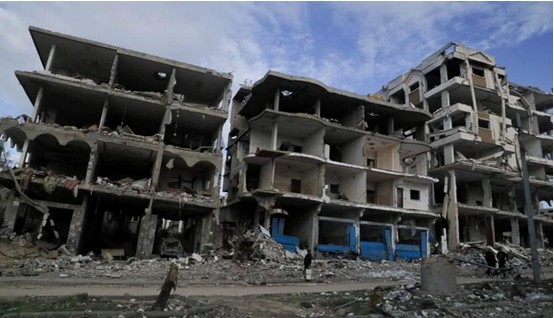Intense Israeli bombardment from air, land, and sea continue to be reported across much of the Gaza Strip on 2 February, resulting in further civilian casualties, displacement, and destruction of civilian infrastructure. Between the afternoons of 1 and 2 February, according to the Ministry of Health (MoH) in Gaza, 112 Palestinians were killed, and 148 Palestinians were injured. Between 7 October 2023 and 13:30 on 2 February 2024, at least 27,131 Palestinians were killed in Gaza and 66,287 Palestinians were injured, according to the MoH.
Some 75 per cent of Gaza’s population of 2.3 million people, more than half of whom are children, are displaced according to UNRWA’s estimates. They face acute shortages of food, water, shelter and medicine. Intense fighting around Khan Younis continues to drive thousands of people into the southern town of Rafah, which is already hosting over half of Gaza’s population. Most are living in makeshift structures, tents, or out in the open, according to UNRWA.

The destruction in the Al-Saftawi and Letwam neighborhoods in northern Gaza after the pull out of the Israeli occupation forces from the region, February 2, 2024 (Photo: WAFA)
The United Nations Conference on Trade and Development (UNCTAD) released on 31 January a report on the social and economic deterioration in Gaza since the beginning of the military operation after 7 October 2023. The report quantifies GDP loss, recovery timelines and the enduring effects on poverty and household expenditure, painting a daunting picture of the development challenges ahead.
Utilizing innovative satellite imagery and official data, UNCTAD estimates that Gaza’s economy had already contracted by 4.5% in the first three quarters of 2023. However, the Israeli military attack greatly accelerated this decline, resulting in a 24% contraction of GDP and a 26.1% drop in GDP per capita for the entire year.
If the current war were to end immediately with reconstruction starting right away and the 2007-2022 growth trends were to persist with an average growth rate of 0.4%, it would take Gaza until 2092 just to restore the GDP levels of 2022, with GDP per capita and socioeconomic conditions continuously declining. However, even with the most optimistic scenario that GDP could grow at 10% annually, it would still take Gaza’s GDP per capita until 2035 to return to its pre-blockade level of 2006.
The recovery of Gaza’s economy from the current military operation will demand a financial commitment several times more than the $3.9 billion that resulted from the 2014 Israeli attack in Gaza and will require a concerted international effort to restore pre-conflict socioeconomic conditions.
Socioeconomic conditions in Gaza were dire in 2022 and in the first half of 2023, with over two million Gazans confined to one of the most densely populated spaces in the world, suffering inadequate access to clean water, sporadic electricity provision and without a proper sewage system. Two thirds of the population lived in poverty, and 45% of the workforce was unemployed before the beginning of the latest military operation.
The ongoing military operation has displaced 85% of Gaza’s population, halting economic activities and further worsening poverty and unemployment.
UNCTAD’s assessment underscores that restoring pre-conflict socioeconomic conditions in Gaza will take decades and requires substantial foreign aid. As of December 2023, unemployment had surged to 79.3%. Meanwhile, 37,379 buildings – equivalent to 18% of the Gaza Strip’s total structures – have been damaged or destroyed by the military operation. The Gaza Strip, half of whose population are children, is now rendered almost uninhabitable, with people lacking adequate sources of income and access to water, sanitation, health or education.
The report highlights the pressing need to break the cycle of economic destruction that has rendered 80% of the population dependent on international aid, warning that a return to the pre-conflict status quo is not an option. “The possibility and speed of recovery in Gaza will depend on when the current military operation ends, the level of donor engagement and the subsequent growth performance of Gaza’s economy. An optimistic scenario suggests that even with an immediate end to the fighting, bringing Gaza back to the socioeconomic conditions that prevailed prior to the outbreak of the current confrontation would take decades without a properly funded recovery programme fully backed by the international community”, UNCTAD said.
However, UNCTAD’s assessment warns that a new phase of economic rehabilitation cannot simply take as its goal a return to the pre-October 2023 status quo. The vicious circle of destruction and partial reconstruction needs to be broken.
According the UN’s organization, Gaza’s economic constraints, rooted in 56 years of occupation and a 17-year blockade, necessitate a thorough understanding and realistic strategies to unlock its growth potential through measures that include restoring the Gaza International Airport, which today is inoperable, building a seaport and enabling the Palestinian government to develop the natural gas fields discovered in the 1990s in the Mediterranean Sea off the shore of Gaza to help finance the reconstruction of infrastructure.
The report emphasizes the importance of providing immediate and robust budget support to the Palestinian government. Such support would help prevent a wider collapse by sustaining governance, delivering essential public services and maintaining aggregate demand through salary payments and the clearance of arrears to the private sector. Foreign aid declined from a total of $2 billion, or 27% of GDP, in 2008 to $550 million, or less than 3% of GDP, in 2022.
UNCTAD underscores that the resolution of Gaza’s crises requires ending the current military operation and lifting the blockade as a pivotal step toward realizing a two-state solution along the 1967 borders, in line with international law and relevant United Nations resolutions.
The full report:
Related: https://maki.org.il/en/


